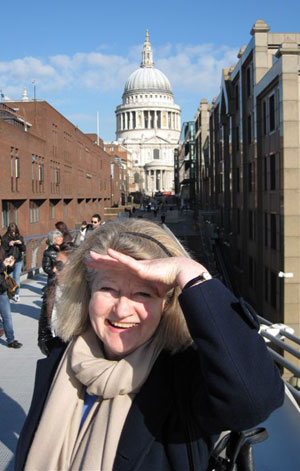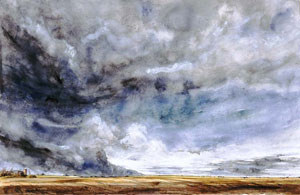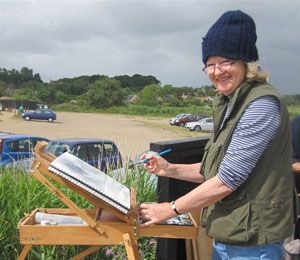Career interview: Cost engineer
Heather MacKinlay's work as an engineer has taken her from the civility of Surrey to the wild west of Australian mining towns and multibillion pound projects in the Algerian desert. And along the way she has also become a successful painter. Heather tells Plus that engineering and painting are just different ways of looking at the world, and how her work as a cost engineer is all about understanding the big picture.

Heather MacKinlay
Playing with ideas
Heather McKinlay seemed destined to become an engineer. Her father was a mechanical and electrical engineer spotted by the Department of Defence to work on secret radar research during the Second World War. Her mother originally followed her family working on lace machines in the industry in Nottingham but ended up constructing some of the first printed circuit boards while working with Heather's father during the war. And her uncles were engineers and her grandfather built bicycles for Raleigh Bicycles. With so much engineering and mechanical mindedness around it doesn't seem surprising that Heather and her brother followed the family tradition and became engineers.
"Daddy was always making stuff or mending stuff. And if I was bored he'd say, oh well, build something. So I'd get out blocks of wood and make a boat or something like that." But in Heather's scientifically curious household building something which looked like a boat wasn't enough. "I'd build it and Daddy would say, hadn't you better test it and see if it floats? So I would go next door to the bathroom and run the bath and test it and it would sink. And he'd ask, why? Did it go all down at once or did it go forwards or backwards?" And with these graphic demonstrations Heather's father began to teach her the principles of science and engineering.
As well as teaching her the practicalities, Heather's father also introduced her to theoretical maths and science from an early age. "You were always conscious that there was a whole load behind these practical things, backing them up," says Heather. At the time her father was studying for further degrees and he would take her in the sidecar of his motorbike to Oxford to get his textbooks. "We would go the the most beautiful and enormous bookshop called Blackwells. And that's where Daddy started teaching me — basic algebra, speed and distance over time, how you could graph information, and how you could take time into smaller and smaller increments until you were actually differentiating it." During Heather's trips to Blackwells she would learn the background to the practical experiments she'd played with at home.
It was these introductions, particularly to the language of mathematics, that prepared Heather for school and fed her appetite to learn more. "I wasn't frightened by the language of algebra or by calculus — I was expecting it." Heather liked pure maths the best at school, but her father had also created very practical background images that the maths could describe. "I appreciated the way equations meant something and the way they were a very precise and explicit language. I appreciated the real beauty of that."
From Manchester...
Heather had spent her childhood inventing and experimenting, so it was a straightforward decision to study mechanical engineering at University of Manchester Institute of Science and Technology (UMIST, now the University of Manchester) in 1965, despite being the only woman on the course. "I was always unusual, not many people were interested in what I was interested in," says Heather.
Being the only woman was a challenge again during her vacation job at a Danish dockyard in the summer of 1966 where they manufactured huge marine deisel engines. "They believed it was unlucky to have a woman on the shop floor." Heather's solution was to get credibility by going up and talking to the workers and learn about the people and what they were doing.
"Even though they didn't have academic training they taught me a huge amount about human nature. A lot of them had worked during the war in occupied Denmark and they showed me drawings where they had broken down guns into small unrecognisable elements that they could manufacture unsuspected inside the factories and smuggled out to assemble as guns. I had an enormous respect for their practicality."
During her degree Heather became fascinated with medical engineering. "The engineers at UMIST and the doctors from Manchester Royal Infirmary got together as they realised there were lots of problems in medicine which engineers had already solved and dealt with every day." One of Heather's vacation jobs was at the Institute of Biometrics and Medical Statistics in Italy where early work was being done using computers for pattern recognition in chromosones and diagnosing heart disease. As part of her degree she sat in on human dissections and her final year project analysed the strength of human bone using photoelastic stress photography to show the stress lines within the hip joint.

"Sung's Pit Lane" by Heather MacKinlay
After university Heather took the chance to be closer to home and worked for a small local engineering company, Pipework and Engineering, in Poole, Dorset, for 18 months. However she planned to follow her interest in medical engineering and applied for a grant from the Medical Research Council to do a masters in biomechanics. But while waiting to hear she was offered an intriguing opportunity: "My uncle wrote from Australia to say, do you fancy two years as a Ten Pound Pom?" At the time the fare of migrants from the UK was subsidised so they were able to travel to Australia for just £10. Her application for the £10 fare came through before she heard back about her masters grant — and so Heather headed off to the other side of the world.
... to the wild-west
In 1971 Heather travelled to Perth, Western Australia. There she joined her uncle at Merz, McLellan and Partners, an electrical engineering consultancy. The company was involved with new mines in the north west of the state and it wasn't long before Heather found herself living in newly established mining towns such as Shay Gap, essentially a construction camp for an iron ore mine that was hundreds of kilometres from the nearest town.
"It was still a bit wild-westish," says Heather. The camp was dry during the week but alcohol was allowed on the weekends. So, as Heather was only 23 and the only woman in the town, on weekends she was taken back to the nearest large town, Port Hedland, where it was considered safe.
Another extreme experience was when cyclones would hit the town. "It was a terribly badly managed site. There was corragated iron lying all over the place and as soon as there was a cyclone the iron whizzes around the air and becomes a lethal weapon. I was not used to that sort of thing but it was exciting and a bit scary!"
But again Heather's natural curiosity, engineering skill and ability to work with people overcame the challenges. Heather was one of the few people there with a degree and found herself managing projects such as the installlation of a fire protection system in a power station. This involved carefully calculating by hand the fluid flow and pressure in the pipes of the new system which would connect with the existing infrastructure in the power station. "We had to link to an existing system. But when they dug it up they found the underground water main for the power station, which was supposed to be a 12 inch [pipe], was actually only 10 inches. The contractor who'd installed it in the first place had actually cheated. So all our pressure calculations were completely up the spout!"
In a massive understatement, Heather describes her experiences working on mining sites in Australia as an interesting comparison to her life in the UK. "I'd worked for six months [as an engineer] in offices in Surrey and it was very gentile. At afternoon tea time the tea trolley would come around and you'd have your cup of tea. And everyone treated me rather like their granddaughter." Things couldn't have been more different to the experience and level of responsibility she had in the North West of Australia. "At one stage I refused to sign a progress payment because work hadn't been done. And for 24 hours they all downed tools — I caused a strike!"
Looking at the bigger picture
Working on the mine sites offered a completely different perspective to engineering at university or working in the engineering practice in Surrey. "It was a very interesting transition from the theory which I'd learnt as part of my degree to putting it into practice, and then seeing what people actually did at the 'coal-face'."

"Cambridgeshire Skies" by Heather MacKinlay
Experiencing so many different perspectives as an engineer helped Heather realise what it was that she actually wanted to do. "In 1971 I was standing in this iron ore mine in the North West of Western Australia measuring the spacing distance between these two holding-down bolts on a motor. I was in the middle of nowhere and there was nothing, absolutely nothing but the eagles flying overhead. And I thought why?
"Then I thought I'm doing this because I'm a tiny cog in an enormous big operation and the objective of that operation is to get iron ore out of the ground, onto a boat and ship it to Japan — sell the iron ore and make money. There was no thought about adding value to the material or setting up an iron ore plant.
"And it kind of dawned on me that I'm interested not in why the distance between these two holding down bolts is right; I'm much more interested in why are we exporting this iron ore to Japan. I was interested in the bigger questions."
Heather decided to change direction and started studying on the newly established MBA course at the University of Western Australia while also working full time. And yet again Heather found herself the only woman, in fact she was the first woman to study the course. "It expanded my vision. I started learning about the financial and organisational aspects of large construction projects. I liked that different perspective."
Calculating the cost
Heather returned to the UK in 1975 when she had nearly finished the MBA. She knew she wanted to use her new financial knowledge and an advertisement for a cost engineer seemed to be the right opportunity. "I didn't know what a cost engineer did but I got the job!"
The role as a cost engineer turned out to be a perfect fit for Heather, bringing together her practical experience as a design engineer and her ability to see the bigger picture. "For a project that is up and running cost engineers monitor the cost against the budget. But what I do more of now is to estimate what the costs of a new project are going to be."
If an energy company want to develop an oil or gas field and establish an offshore processing platform, Heather provides cost estimates of the different options for constructing the project. There might be two or three ways of doing it:several platforms; or subsea wells loading to a buoy; or a tension leg platform tethered by cables to the sea bed. "My role is to say, this solution will cost you 400 million dollars, that solution will cost you 350 million dollars, and the phasing of the expenditure would be like this." As these are vast projects that occur over extended periods Heather needs to take time into account, and with that the changing price of oil, gas and fluctuating currencies.
Heather works with engineers who focus on individual elements of the project. "An engineer will design something that needs a compressor and they'll know exactly what sort of machine they need — a 5 megawatt output and so on. But if they went out and bought it it wouldn't do anything, it would get delivered and sit there in a box!" But in order to make that compressor work in the middle of, say, the Algerian desert or off the east coast of Siberia, Heather has to understand how to ship it, inspect it, install it and run it and estimate these additional increments of cost.

"Cape Wrath Scotland" by Heather MacKinlay
Heather's role is to consider how all these individual elements fit together, and also all the planning required to make the project happen in the real world. "I'm starting from when there is nothing on the ground at all — there's just desert or ice flow or ocean — there's not a road to get there or any infrastructure." As well the engineering work to build the plant itself, Heather has to take into account the number and type of people required for projects, as well as how to make it all happen in these isolated environments.
Over the last 15 years working as a consultant for Granherne, Heather has developed a computer program to develop cost estimates for these massive projects. The program is a set of interlinked spreadsheets containing all the possible steps and incremental costs involved. "It's just like a story of how to deliver this [project]. How many man hours will it cost? How many people have we got? Does it involved electrical or mechanical expertise? You build up a mental team of the people it's going to take and over what period of time. And once I've done my first pass analysis estimating the costs of the different options, the oil companies economists make the final decision which option they'll go with."
"It's an interesting interface between what engineering engineers do and what cost people do. I have to mediate between what the project manager understands and what the accountant understands: the accountant won't understand the engineering detail and the engineer, generally speaking, won't understand the accounting detail."
Fundamental language
Mathematics is absolutely fundamental to Heather's work as a cost engineer. As well as managing the financial aspects of the project mathematics is vital in satisyfing legislative requirements for issues such as safety. "All our consultants have a very strict control process of calculations. And there is a rigorous process of demonstrating that we've done those calculations and they have been cross-checked."
For those interested in working as an engineer, regardless of the variety, Heather recommends that people study mathematics for as long as possible. "I think it's important to keep your maths going for as long as you enjoy it and want to do it. It's such a fundamental language. If you keep your maths going you can move in lots of directions into any engineering discipline."
A different way of translating the world

Heather painting.
In addition to her career as an engineer, Heather is also a successful painter. Her passion for art started very young: "We were a very practical family, we were always all making things." Her father was also a water colour painter and a theatre designer, and Heather has followed in his footsteps. As well as the beautiful examples of her painting that illustrate this article, you can see many more at her website. Heather's work has been exhibited widely in Australia and the UK, including in the Royal Watercolour Society Bankside Gallery in London.
Despite people's surprise, for Heather the worlds of art and engineering and maths fit together well: "I don't see them as anything alien from each other. My art is just putting something down on a flat piece of paper that is actually three dimensions. And in a way that is exactly what I'm doing my computer program [for my work as a cost engineer]. They are an abstract representation of something physical."
Heather's painting is another illustration of the different perspective she uses to express the world. And with a career that has spanned the globe and environments ranging from gentile offices to frontier mining sites, Heather has an enviable pool of artistic inspiration to draw from.
About the author
Rachel Thomas is co-editor of Plus.

More from Maths Careers
You can find out more about careers with mathematics on the Maths Careers website, which is run by the Institute of Mathematics and its Applications. In particular you might want to look at these career profiles on the Maths Careers site: